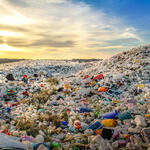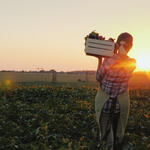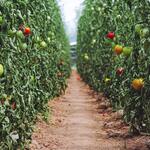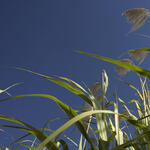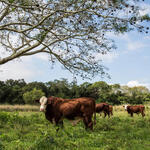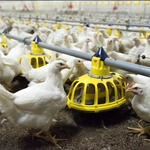- Date: 25 August 2021
Every year, 11 million metric tonnes of plastic is leaked into the oceans. By 2050, there could be more plastic in the ocean than fish by weight. This issue is compounded by the fact that there is not a clear picture of where mismanaged plastic (plastic that ends up landfilled, littered, or leaked into nature) is ending up in the world, and in what quantities. Understanding where plastic is being mismanaged is crucial for mitigating leakage and informing intervention strategies. Unfortunately, national estimates of mismanaged plastic can vary significantly depending on the data sources and modelling approaches used.
- Date: 23 August 2021
- Author: Sheila Bonini, Senior Vice President, Private Sector Engagement, WWF
Fourteen years ago, World Wildlife Fund and The Coca-Cola Company decided to embark on a great experiment: an environmental organization and a for-profit company joining forces to ensure access to quality water for communities, nature, and business around the globe. Our partnership scope has since expanded to include collaboration on additional issues critical to the health and well-being of our planet and its inhabitants, including climate, plastics, and agriculture.
What was novel in 2007 has now become the gold standard for corporate/NGO partnerships, and we’re incredibly proud for our part in proving just how successful this model can be. The launch of the Coca-Cola and WWF partnership has catalyzed global cooperation. Over the past 14 years we’ve worked together in 35 geographies spanning 50 countries, and across all nine of Coca-Cola’s operating units. The projects are as different as the landscapes and communities they serve. Examples include everything from restoring inactive farmland to wetlands in the Yangtze River basin, training and equipping wildfire fighters in Guatemala, reconnecting the Danube River system to floodplains, removing “thirsty” invasive plant species in South Africa, and much, much more.
We detail many of these projects in our new Partnership Impact Report, celebrating all we’ve accomplished throughout the first two phases of the Coca-Cola and WWF partnership. And we’re pleased to announce that our work will continue as we embark on Phase III.
In fourteen years the world has changed dramatically due to climate change. The next phase of our partnership is expanding to also focus on climate resilience. We plan to invest in nature to help meet the challenges ahead, without leaving anyone behind. Together, we will work to help communities that face barriers become more resilient in the face of the climate crisis and water stresses, and help reimagine how the company sources, uses, recycles and reduces plastic packaging, all while evolving the company’s strategies and goals to reduce its environmental footprint.
Recognizing that the leadership of local communities is critical for success at scale, we also plan to support project implementation in more than 50 countries, and engage hundreds of additional stakeholders around the world. Our partnership has always been about more than just our two organizations – and we look forward to taking that collaboration to a whole new level in Phase III, for the benefit of people, business, and nature.
- Date: 02 August 2021
- Author: Melissa D. Ho, Senior Vice President, Fresh Water and Food, WWF
Food plays a role in our lives far beyond sustenance. Communal meals shared with family and friends can strengthen bonds and relationships; cultural identity and tradition is engrained in the recipes we create, consume, and share; and societies were built and evolved from humans’ ability to produce food for their communities by stewarding the land on which that food is grown. Given food’s pervasive role in our society and the scale of its impacts, it always surprises me that food systems and the communities that have the power to transform them have not been higher on the political, development, and climate agenda.
- Date: 20 July 2021
- Author: Leigh Prezkop, Food Loss and Waste Specialist, WWF
Grower Adoption of a Food Loss Metric is Key to Reducing Specialty Crop Loss
By now, people have started to realize that food waste is a pretty big issue. We know millions of tons of food in the US are being wasted in food service, retail, and our own kitchens. A lesser known, and often not as well measured, part of the issue happens on farms due to drivers and decisions made throughout the whole supply chain. In fact, new research out of WWF-UK shows that as much as 1.2B tons of food is lost on farms during, around, and after harvest. This is equivalent to about 15% of all food produced.
For the last several years, through WWF’s No Food Left Behind initiative, we have been working closely with specialty crop farmers and other partners to examine how loss of certain crops is measured on farms and what drives that loss. The reality is that loss is not measured consistently or transparently for fruit and vegetables, which makes it challenging to understand why it’s happening or how it can better be avoided. There’s a complex web of factors that drive this loss. Market structures that separate farmers from buyers, retail specifications, labor shortages, unpredictability of weather events, market dynamics, and inflexible, short-term contracts are all contributing factors.
- Date: 15 July 2021
Plastic pollution is rapidly becoming one of the most devastating issues facing our planet – yet despite this growing crisis, plastic plays a vital role in our society. From keeping our food fresh to supporting life-saving medical devices, plastic is deeply imbedded in many of our essential services. Getting rid of it is not an option, nor should it be the goal.
Even in a circular economy that maximizes the reuse, recovery, and recycling of all plastic, some virgin plastic will still be necessary because no material is capable of infinite recycling without losses to quality and quantity. Many industries will continue to require virgin plastic to maintain health and safety standards.
To truly curb the plastic pollution crisis, we must therefore adopt a multifaceted approach – one in which we not only push for the transition to a circular system, but also utilize renewable and responsibly sourced feedstocks to replenish essential lost material. While currently 99% of new plastics are made from harmful fossil fuels that contribute to climate change, an emerging plant-based plastic market could provide a more sustainable alternative. Plant-based plastics – made from seaweed, sugar beet and other plants – can serve a strong complementary role to a circular economy while reducing our dependence on fossil fuels.
However, to yield true positive impacts, plant-based materials must be responsibly sourced and managed. That’s why World Wildlife Fund initiated the Bioplastic Feedstock Alliance (BFA) in 2013, convening some of the world’s leading consumer brands to advance our knowledge of plant-based plastics and to explore the potential environmental and social impacts of these materials. With much still unknown, one thing is clear: the solution must not exacerbate the problem.
The BFA is therefore calling on policy makers to ensure any future policy on plastic alternatives is grounded in science. In the race to realize a circular economy, plant-based plastics will be key – however policies should require sustainability metrics be used to evaluate their production and sourcing, looking at environmental indicators such as water use, carbon emissions, and impacts on communities and wildlife. Not only will this approach guarantee plant-based plastics remain responsibly managed, but it will incentivize continuous improvement that ultimately leads to the lowest environmental impact.
Achieving a circular plastic system will require bold and innovative solutions – yet choosing the right solutions will involve navigating complex tradeoffs. New policies in the plant-based plastics space must be based on credible sustainability science to maximize positive environmental impacts. Only then can we transition to a more circular plastic system, one that benefits both people and the planet.
You can read the BFA’s full Call for Science-Based Policy on Plastic Alternatives here.
The Bioplastic Feedstock Alliance provides thought leadership on the responsible sourcing of bioplastics, and the role of bioplastic in circular systems. The BFA explores the latest science to advance knowledge of bioplastics and their social and environmental impacts. The BFA aims to ensure bioplastics ultimately contribute to a more sustainable flow of materials, to create lasting value for present and future generations. Visit https://bioplasticfeedstockalliance.org/ for more information.
- Date: 14 July 2021
- Author: Christa Anderson and Martha Stevenson, World Wildlife Fund
Nature-Based Solutions in Science-Based Targets
Many companies strive to include Nature-Based Solutions (NBS) in their climate strategies within the Science Based Targets initiative (SBTi).1 When done right, NBS for climate mitigation are a genuine win-win. Companies deliver on their climate goals and simultaneously support nature and address societal challenges. Here we provide a brief outline of how NBS fit into Science-Based Targets and what’s coming soon.
- Date: 13 July 2021
- Author: Karla Canavan, VP, Commodity Trade and Finance, Katherine Devine, Director of Business Case Development, WWF
Before net-zero commitments became all the rage, companies were pledging to eliminate deforestation from their supply chains. Deforestation and habitat conversion are powerful contributors to climate change, accounting for about 15% or more of global GHG emissions. Despite increasing numbers of commitments and a decade of effort in some cases, companies have struggled to achieve them. It’s not surprising; there are many complex issues in supply chains that could contribute to deforestation and conversion. These range from multiple direct and indirect suppliers, lack of traceability, lack of government support, fluctuating market forces—such as increasing global demand from China, and more. Nevertheless, addressing the challenge of taking deforestation and conversion out of global supply chains (Deforestation- and Conversion-Free, or DCF) can not wait.
- Date: 12 July 2021
- Author: Monica McBride, Director, Agricultural and Environmental Metrics, WWF
Feeding animals, particularly those on farms, with food scraps or waste is an age-old practice. In fact, 30% of what’s fed to livestock around the world today is either waste from food supply chains or by-products from growing and processing food. In the US, about 10% of surplus food is already being sent to feed animals, most coming from manufacturing or grocery stores.
But there’s another 14.7 million tons of food waste in the US that could be safely used for animal feed, instead of going to landfills where it produces methane emissions that intensify climate change. More circular systems that repurpose nutrients for feed can also help to reduce other major environmental impacts of producing feed crops like land, energy, and water use, while bolstering food security.
- Date: 01 July 2021
- Author: Katherine Devine, Director of Business Case Development, WWF
COVID-19 has led to a home purchasing boom due to low interest rates, with many choosing to move to suburban areas and take advantage of the opportunity to have more space while working from home. For many who were fortunate to shift their jobs to work remotely, the time may have enabled a re-orienting of how time outside of work is spent, with reduced commutes, greater focus on family and hobbies, an acceleration of online shopping habits and home cooking, as well as other changes. Not all changes will stick, but with a significant portion of the population (20-25% for 3-5 days a week, according to McKinsey) likely to have either fully remote or partially remote work options, can that shift also enable more sustainable use of stranded assets?
Not all employees are able or want to work at home full time. Different work styles, home office setups, equipment, high speed internet, or even desire and preference to socialize with coworkers may mean blended models of partial remote work will become more prominent. Furthermore, childcare has proven to be a challenge for working families, leading to an unprecedented exodus of (primarily) women from the workforce. Repercussions of this shift will likely impact the workforce for years to come. While some challenges will be mitigated, for example as vaccines allow schools to reopen, others remain. What if abandoned or underutilized shopping malls in suburban areas could be revitalized to meet several of these needs?
- Date: 30 June 2021
- Author: Katherine Devine, Director of Business Case Development, Markets Institute, WWF
COVID-19 transformed urban spaces from bustling city centers to deserted concrete landscapes. While downtowns may soon return to greater normalcy, it is likely that many aspects of office culture will change. Some companies, such as Twitter and Zillow, have declared that employees can choose to work remotely indefinitely, and more organizations will follow suit either with fully remote work or blended models. This may well lead to a massive transformation of office culture, amenities, and the makeup of city centers and suburban office parks. But how can these changes be leveraged to enable a more sustainable food system?
